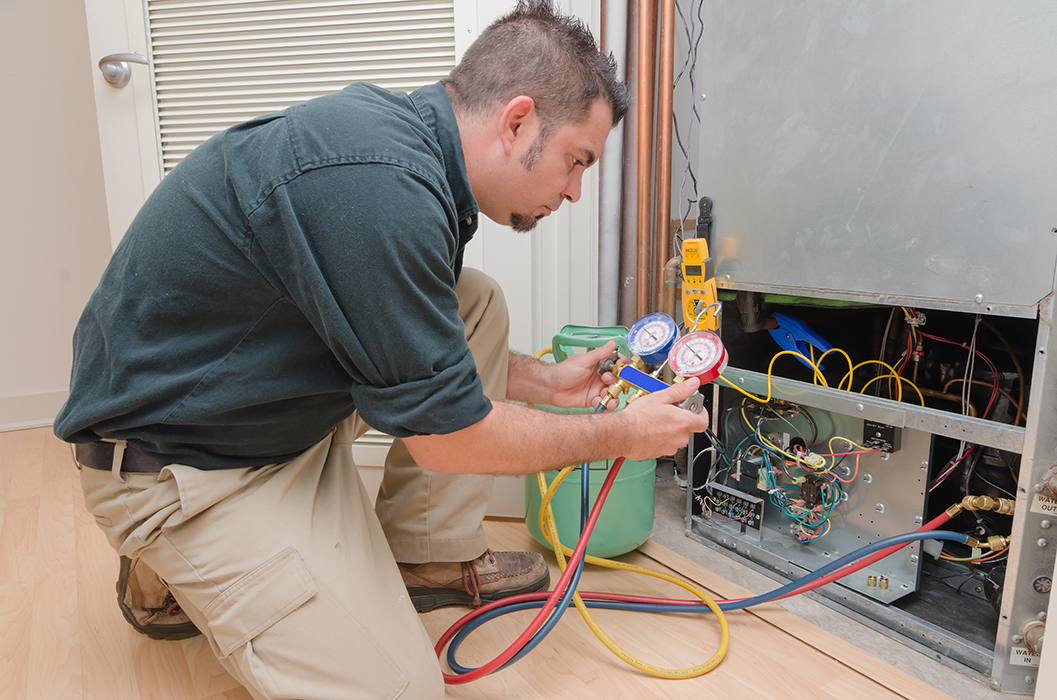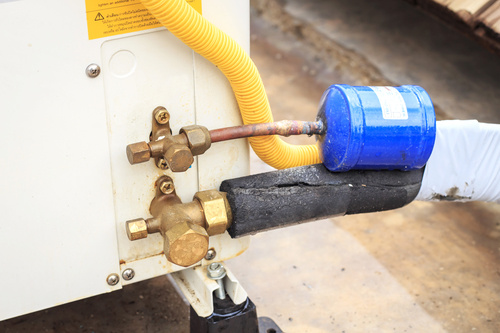The American Society of Heating Refrigerating and Air-Conditioning Engineers (ASHRAE) defines air-conditioning as treating air and controlling it’s temperature, humidity, cleanliness and distribution to satisfy the requirements of a particular space. To maintain a high level of comfort, the air must be cooled or heated to the optimum temperature to create an ideal environment.
Does your air conditioner need service right away? Click Here!
Types of Air Conditioners
Air-conditioners are divided into central ducted systems and split units. Split units are installed in specific rooms of a property. The temperature is adjusted according to the room’s requirements and allows individual users to control the air. Central systems control the interior of the entire building through vents. The operating system is housed on the exterior of the property.
Over time, air-conditioners require maintenance. Since a cooling system comprises several components, it requires regular maintenance services to ensure its effective operation. One of those issues could be a refrigeration leak. Should you feel your system is less effective and not cooling the interior efficiently, it may require a professional. Another sign to watch out for is a spike in your energy bill. Your first reaction is to push the cooling system to its max, which demands more power and results in a larger bill.
What is a Service Valve?
One of the most important parts of your cooling system is the service valve (or service port). If you’ve called in HVAC specialists for air conditioner service, you may notice all the hoses and other gear he brings to check out any problems. Your technician uses these tools in conjunction with the service valve to check out your unit’s performance issues.
Ultimately, the service valve refers to a section on your air conditioner that houses various ports for the technician to connect, and this is how they determine the faults in your system. Generally, they’re located among the refrigeration lines near the compressor on the outside. It’s effectively the bridge between the technician’s equipment and your air conditioning system.
Furthermore, they use a service valve to separate one piece of equipment from another. In air conditioner service applications, the valve allows a technician to remove refrigerant from the unit without requiring removal of the system charge. The valves will enable this work without interfering with the regular operation of the unit.
Service Valve Usage
Much like the valve on your car’s tire, service valves are airtight unless they are attached to a connection that opens the orifice. There’s a wealth of information an air conditioner service technician can glean – and several services that technicians can perform – via the service valves of your A/C unit:
- In the event of overcharging, a technician can use these access points to remove refrigerant safely,
- Force new replacement refrigerants into the lines.
- Add additional refrigerant to “top off” loss due to a leak.
- A technician can measure the refrigerant gas pressure in the system.
The Servicing Process
The refrigerant is vented out during a service and the air-conditioner fully recharged. If the recovery of the refrigerant is done correctly, it will save you on refrigeration consumption. A common mistake technicians make is topping up the refrigeration without investigating if there’s a leak. This error leads to refrigerant being released into the atmosphere, which is detrimental to the environment. The efficiency of the system decreases while power consumption increases, leading to a rise in carbon dioxide consumption which is harmful to the environment. To extend the life of the equipment, recovery of refrigerant, leak-, and pressure testing are critical during a service.
The Leak Detection Process
You should ensure that your technician conducts leak and pressure tests to protect the environment and ensure your cooling system is operating optimally. Identifying refrigerant leakage using the soap solution is by far the most affordable. Apply the soap solution to the joints, connections and fittings while the system is running. The electronic method involves a detector that contains elements that identify a particular chemical ingredient in the refrigerant. There is an audible clicking, and the flashing of a light signifies a leak is present.
Why You Should Service Your System
Failing to service your HVAC system is a huge mistake that will cost you an opportunity to save energy. Apart from that, you and your family would have to endure inadequate airflow, which is uncomfortable. Faulty equipment cannot control the humidity levels. As a result of plugged condensate drains, mold is likely to develop and cause massive health problems. There is a possibility of electric shock due to the nature of the grounding of the equipment. As a result, the entire system fails due to the coil freezing from low refrigerant charge and other contaminants in the refrigeration line.
What About Those Hoses?
If you’re wondering why your air conditioner service technician arrives with a bundle of hoses, they’re attached to gauges that test and repair your A/C unit at the service valves. The hoses attach to a gauge mechanism on one end and lock onto the service valves on the other end. The technician uses a hand release to open up the service valves, which allows the refrigerant pressure to reach either the low or high-pressure connection of the gauges.
The gauges report the refrigerant levels and will enable the air conditioner service technician to determine whether the charge is sufficient or if recharging with more refrigerant is required.
Refrigerant
Refrigerant is a chemical that produces a cooling effect and is used by your air conditioning system to transfer heat to the outside air. There are two refrigerants currently in use in the U.S., but by 2020 one – R22 – will be completely phased out due to environmental concerns. Today, the most widely used refrigerant is R410A, a chlorine-free chemical that meets the EPA’s newest and most stringent environmental guidelines. Until R-22 is completely phased out, your air conditioner service technician can ensure that they use the correct gauges with your system.
The Importance of Correct Refrigerant Charge
Refrigerant is an essential component in the effective operation of your HVAC system, thus having the correct amount of refrigerant is crucial. Additionally, an incorrect charge will cause damage to the system. If it’s overcharged, there is a possibility that the refrigerant won’t evaporate all the way through and could slow down the compressor. Conversely, too little charge can lead to the formation of ice on the evaporator, therefore, restricting heat transfer and reducing the airflow.
Behind the Numbers
In a study done on around 4000 HVAC residential systems in California, 34% were undercharged, 28% were overcharged with only 38% having the correct charge. While that number is the highest, when put into context, it’s not a great number. The conclusion of the study noted that a large number of systems are operating at less than their full capacity.
General Good Practices Relating to Servicing
When you’ve hired an HVAC contractor, make sure they’re following these practices to ensure your safety and overall contribution to the environment.
- Wear the correct personal protective equipment such as gloves, goggles, and clothing to cover the whole body.
- Be aware that the pressure in the system is higher than atmospheric pressure.
- The refrigerant in the air-conditioner may contain acids and can cause damage to the skin.
- Ensure the hoses don’t have cracks and are strong enough to handle extreme pressure.
- Charge the system with the correct quality and quantity of refrigerant.
- Ensure the service valves are in good condition and capped when not used.

The Role of Air Conditioner Service Valves in System Efficiency
Service valves play a crucial role in maintaining the efficiency of your air conditioning system. These valves control the flow of refrigerant, allowing HVAC technicians to diagnose, repair, and recharge the system without causing major disruptions. A properly functioning service valve ensures that refrigerant is contained within the system, preventing leaks that could lead to performance issues and increased energy costs. When these valves become faulty, they can cause refrigerant loss, leading to inefficient cooling and even compressor failure. Regular inspections of service valves help extend the lifespan of your AC unit and ensure optimal performance.
Common Issues with AC Service Valves
Like any mechanical component, air conditioner service valves can wear down over time. One of the most common problems is valve leakage, which can occur due to worn-out seals or improper tightening during maintenance. Another issue is valve clogging, often caused by debris or refrigerant contaminants. If a service valve is stuck or difficult to open, it may indicate internal damage that requires immediate attention. A malfunctioning service valve can lead to refrigerant loss, inconsistent cooling, and even increased wear on the compressor. If you notice hissing sounds, reduced cooling efficiency, or unexpected energy spikes, it may be time to have your service valves checked.
Upgrading to High-Quality Service Valves
Not all service valves are created equal. Older models may be prone to leaks and corrosion, reducing the efficiency of your HVAC system. Modern service valves come with advanced sealing technologies and improved materials that offer better durability and performance. Some high-quality options feature brass construction, Teflon seals, and reinforced threads to prevent leaks. If you’re frequently experiencing refrigerant issues, upgrading your AC unit’s service valves could be a simple yet effective solution. Investing in high-quality valves ensures a tighter seal, reduces maintenance costs, and improves the overall longevity of your cooling system.
Conclusion
Understanding how your air conditioning system works is an excellent step towards achieving peace of mind that the air conditioner service you receive is both technically skilled and competitively priced. You can learn more about how your entire HVAC system operates by checking out some of our other blog posts.



